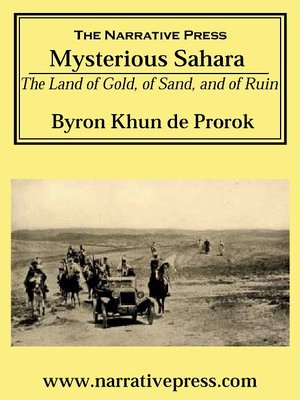
Sign up to save your library
With an OverDrive account, you can save your favorite libraries for at-a-glance information about availability. Find out more about OverDrive accounts.
Find this title in Libby, the library reading app by OverDrive.



Search for a digital library with this title
Title found at these libraries:
| Loading... |
In Mysterious Sahara Prorok, a popular archeologist and adventurer of the time, describes his 1925-28 expeditions into north Africa. He goes south from Algeria, across the Sahara, and into the mountains of the Hoggar.
The first chapter of this book is a rather grim but fascinating roll call of early Saharan explorers. The list goes on and on, and almost all of them died horribly. Sometimes it was thirst or hunger, but usually it was at the hands of the Taureg, the giant "white" race of the Sahara, in which the men wear veils and are dressed from head to toe in black. Prorok himself, throughout all of his books, keeps up a rather chipper tone, which diverts the reader from the fact that hundreds of explorers died in the very same tracks. This isn't Disneyland.
On his way to find the Taureg, Prorok stops by the temple of Jupiter Ammon, "where Alexander the Great became a god," and then visits the Troglodytes of the Matmatas, who were living Neanderthals.
Somewhere south of the Mountain of Snakes, Prorok finds the Tauregs. They are every bit the tall, silent warriors and bandits he expected them to be. There are about 5,000 of them, living in a feudal system, still carrying the swords of the crusaders, with jewelry and coins from the 17th century. Everywhere Prorok sees links between the Tauregs and medieval Europe -- and Atlantis. He also describes the Tauregs as a near super-race. He saw men run straight at a bar six feet off the ground and clear it with a single jump. His photographer shot 40,000 feet of motion picture film.
But Prorok and his companions never relaxed:
"There is no question but what one feels the malignity that envelops the hidden personality of the Taureg, and at times it is surprisingly easy to recall the death-dealing spear that traversed Reygasse's tent one silent night, or the tombs of Palat and Douls and Flatters, far out in the sands, or what is far more tragic because of its nearness to me, the passing of some of my own brave comrades, killed by Taureg as I write these lines."
In December, 1928, after Prorok's sojourn with the Tauregs, his friends, General Clavery and Captains Debenne, Pasquet, and Resset were massacred on the road to Beni Abbes. A few months later 83 French officers and men were killed by the Tauregs at Ain Yacoub.
One reason Prorok lingered with the Tauregs was that he wanted to find the tomb of their queen, Tin Hinan, which would contain clues to the Taureg's mysterious origin. On October 18, 1927, he found the tomb. He had to excavate in a hurry, however, before the Tauregs realized whose tomb it was. With only a few companions, out of food and almost out of water, he dug. Near the top of the tomb they found Roman coins from the time of Emperor Constantine and other relics from the faraway Mediterranean. Then they found the queen herself, draped with precious jewels.
Just as the Tauregs were about to descend and wipe out the party, reinforcements arrived with food and weapons, and de Prorok escaped with his treasures.
Some of this material is also covered in the author's In Quest of Lost Worlds (1935), but Prorok goes into far better (and different) detail here. Mysterious Sahara is a book you will probably read more than once. Check out Prorok's other books as well: Digging for Lost African Gods (1926), and Dead Men Do Tell Tales (1942). All are available from The Narrative Press.






